Konstantinos N. Plataniotis
TiP4GEN: Text to Immersive Panorama 4D Scene Generation
Aug 17, 2025Abstract:With the rapid advancement and widespread adoption of VR/AR technologies, there is a growing demand for the creation of high-quality, immersive dynamic scenes. However, existing generation works predominantly concentrate on the creation of static scenes or narrow perspective-view dynamic scenes, falling short of delivering a truly 360-degree immersive experience from any viewpoint. In this paper, we introduce \textbf{TiP4GEN}, an advanced text-to-dynamic panorama scene generation framework that enables fine-grained content control and synthesizes motion-rich, geometry-consistent panoramic 4D scenes. TiP4GEN integrates panorama video generation and dynamic scene reconstruction to create 360-degree immersive virtual environments. For video generation, we introduce a \textbf{Dual-branch Generation Model} consisting of a panorama branch and a perspective branch, responsible for global and local view generation, respectively. A bidirectional cross-attention mechanism facilitates comprehensive information exchange between the branches. For scene reconstruction, we propose a \textbf{Geometry-aligned Reconstruction Model} based on 3D Gaussian Splatting. By aligning spatial-temporal point clouds using metric depth maps and initializing scene cameras with estimated poses, our method ensures geometric consistency and temporal coherence for the reconstructed scenes. Extensive experiments demonstrate the effectiveness of our proposed designs and the superiority of TiP4GEN in generating visually compelling and motion-coherent dynamic panoramic scenes. Our project page is at https://ke-xing.github.io/TiP4GEN/.
The Missing Point in Vision Transformers for Universal Image Segmentation
May 26, 2025Abstract:Image segmentation remains a challenging task in computer vision, demanding robust mask generation and precise classification. Recent mask-based approaches yield high-quality masks by capturing global context. However, accurately classifying these masks, especially in the presence of ambiguous boundaries and imbalanced class distributions, remains an open challenge. In this work, we introduce ViT-P, a novel two-stage segmentation framework that decouples mask generation from classification. The first stage employs a proposal generator to produce class-agnostic mask proposals, while the second stage utilizes a point-based classification model built on the Vision Transformer (ViT) to refine predictions by focusing on mask central points. ViT-P serves as a pre-training-free adapter, allowing the integration of various pre-trained vision transformers without modifying their architecture, ensuring adaptability to dense prediction tasks. Furthermore, we demonstrate that coarse and bounding box annotations can effectively enhance classification without requiring additional training on fine annotation datasets, reducing annotation costs while maintaining strong performance. Extensive experiments across COCO, ADE20K, and Cityscapes datasets validate the effectiveness of ViT-P, achieving state-of-the-art results with 54.0 PQ on ADE20K panoptic segmentation, 87.4 mIoU on Cityscapes semantic segmentation, and 63.6 mIoU on ADE20K semantic segmentation. The code and pretrained models are available at: https://github.com/sajjad-sh33/ViT-P}{https://github.com/sajjad-sh33/ViT-P.
Advancements in Medical Image Classification through Fine-Tuning Natural Domain Foundation Models
May 26, 2025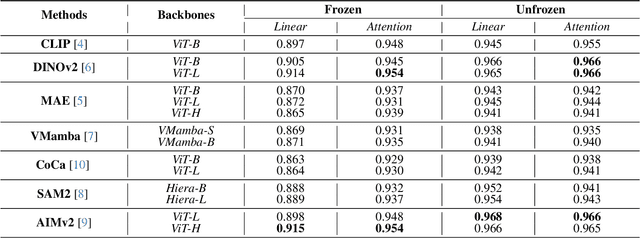
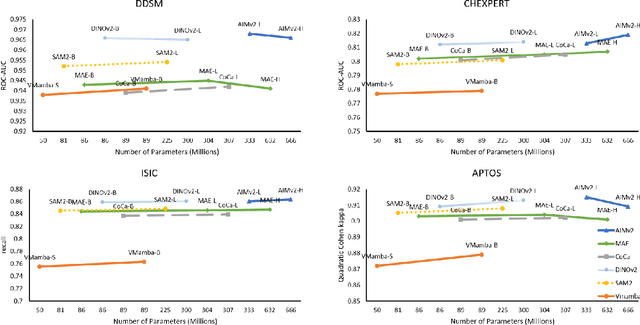
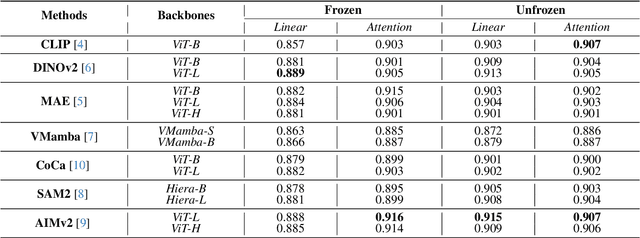
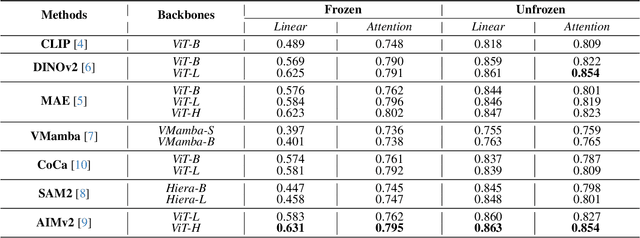
Abstract:Using massive datasets, foundation models are large-scale, pre-trained models that perform a wide range of tasks. These models have shown consistently improved results with the introduction of new methods. It is crucial to analyze how these trends impact the medical field and determine whether these advancements can drive meaningful change. This study investigates the application of recent state-of-the-art foundation models, DINOv2, MAE, VMamba, CoCa, SAM2, and AIMv2, for medical image classification. We explore their effectiveness on datasets including CBIS-DDSM for mammography, ISIC2019 for skin lesions, APTOS2019 for diabetic retinopathy, and CHEXPERT for chest radiographs. By fine-tuning these models and evaluating their configurations, we aim to understand the potential of these advancements in medical image classification. The results indicate that these advanced models significantly enhance classification outcomes, demonstrating robust performance despite limited labeled data. Based on our results, AIMv2, DINOv2, and SAM2 models outperformed others, demonstrating that progress in natural domain training has positively impacted the medical domain and improved classification outcomes. Our code is publicly available at: https://github.com/sajjad-sh33/Medical-Transfer-Learning.
DD-Ranking: Rethinking the Evaluation of Dataset Distillation
May 19, 2025Abstract:In recent years, dataset distillation has provided a reliable solution for data compression, where models trained on the resulting smaller synthetic datasets achieve performance comparable to those trained on the original datasets. To further improve the performance of synthetic datasets, various training pipelines and optimization objectives have been proposed, greatly advancing the field of dataset distillation. Recent decoupled dataset distillation methods introduce soft labels and stronger data augmentation during the post-evaluation phase and scale dataset distillation up to larger datasets (e.g., ImageNet-1K). However, this raises a question: Is accuracy still a reliable metric to fairly evaluate dataset distillation methods? Our empirical findings suggest that the performance improvements of these methods often stem from additional techniques rather than the inherent quality of the images themselves, with even randomly sampled images achieving superior results. Such misaligned evaluation settings severely hinder the development of DD. Therefore, we propose DD-Ranking, a unified evaluation framework, along with new general evaluation metrics to uncover the true performance improvements achieved by different methods. By refocusing on the actual information enhancement of distilled datasets, DD-Ranking provides a more comprehensive and fair evaluation standard for future research advancements.
Dynamic Vision Mamba
Apr 07, 2025



Abstract:Mamba-based vision models have gained extensive attention as a result of being computationally more efficient than attention-based models. However, spatial redundancy still exists in these models, represented by token and block redundancy. For token redundancy, we analytically find that early token pruning methods will result in inconsistency between training and inference or introduce extra computation for inference. Therefore, we customize token pruning to fit the Mamba structure by rearranging the pruned sequence before feeding it into the next Mamba block. For block redundancy, we allow each image to select SSM blocks dynamically based on an empirical observation that the inference speed of Mamba-based vision models is largely affected by the number of SSM blocks. Our proposed method, Dynamic Vision Mamba (DyVM), effectively reduces FLOPs with minor performance drops. We achieve a reduction of 35.2\% FLOPs with only a loss of accuracy of 1.7\% on Vim-S. It also generalizes well across different Mamba vision model architectures and different vision tasks. Our code will be made public.
Wonderland: Navigating 3D Scenes from a Single Image
Dec 16, 2024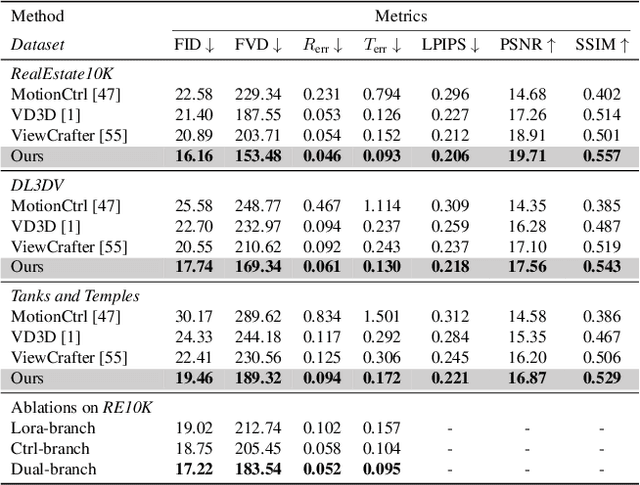


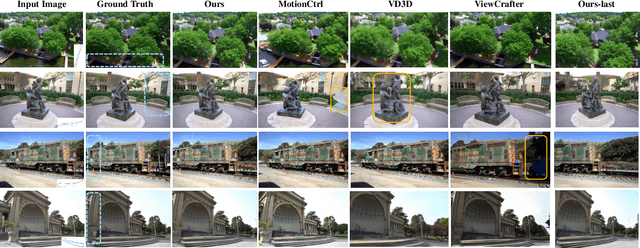
Abstract:This paper addresses a challenging question: How can we efficiently create high-quality, wide-scope 3D scenes from a single arbitrary image? Existing methods face several constraints, such as requiring multi-view data, time-consuming per-scene optimization, low visual quality in backgrounds, and distorted reconstructions in unseen areas. We propose a novel pipeline to overcome these limitations. Specifically, we introduce a large-scale reconstruction model that uses latents from a video diffusion model to predict 3D Gaussian Splattings for the scenes in a feed-forward manner. The video diffusion model is designed to create videos precisely following specified camera trajectories, allowing it to generate compressed video latents that contain multi-view information while maintaining 3D consistency. We train the 3D reconstruction model to operate on the video latent space with a progressive training strategy, enabling the efficient generation of high-quality, wide-scope, and generic 3D scenes. Extensive evaluations across various datasets demonstrate that our model significantly outperforms existing methods for single-view 3D scene generation, particularly with out-of-domain images. For the first time, we demonstrate that a 3D reconstruction model can be effectively built upon the latent space of a diffusion model to realize efficient 3D scene generation.
Data-to-Model Distillation: Data-Efficient Learning Framework
Nov 19, 2024Abstract:Dataset distillation aims to distill the knowledge of a large-scale real dataset into small yet informative synthetic data such that a model trained on it performs as well as a model trained on the full dataset. Despite recent progress, existing dataset distillation methods often struggle with computational efficiency, scalability to complex high-resolution datasets, and generalizability to deep architectures. These approaches typically require retraining when the distillation ratio changes, as knowledge is embedded in raw pixels. In this paper, we propose a novel framework called Data-to-Model Distillation (D2M) to distill the real dataset's knowledge into the learnable parameters of a pre-trained generative model by aligning rich representations extracted from real and generated images. The learned generative model can then produce informative training images for different distillation ratios and deep architectures. Extensive experiments on 15 datasets of varying resolutions show D2M's superior performance, re-distillation efficiency, and cross-architecture generalizability. Our method effectively scales up to high-resolution 128x128 ImageNet-1K. Furthermore, we verify D2M's practical benefits for downstream applications in neural architecture search.
Leveraging Foundation Models for Efficient Federated Learning in Resource-restricted Edge Networks
Sep 14, 2024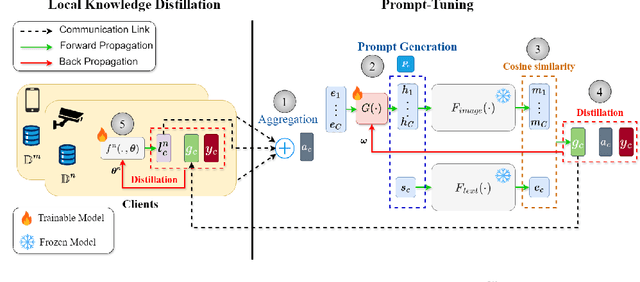

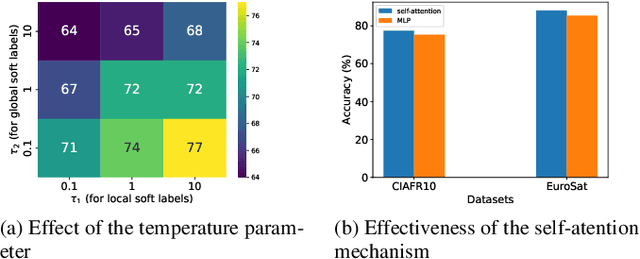
Abstract:Recently pre-trained Foundation Models (FMs) have been combined with Federated Learning (FL) to improve training of downstream tasks while preserving privacy. However, deploying FMs over edge networks with resource-constrained Internet of Things (IoT) devices is under-explored. This paper proposes a novel framework, namely, Federated Distilling knowledge to Prompt (FedD2P), for leveraging the robust representation abilities of a vision-language FM without deploying it locally on edge devices. This framework distills the aggregated knowledge of IoT devices to a prompt generator to efficiently adapt the frozen FM for downstream tasks. To eliminate the dependency on a public dataset, our framework leverages perclass local knowledge from IoT devices and linguistic descriptions of classes to train the prompt generator. Our experiments on diverse image classification datasets CIFAR, OxfordPets, SVHN, EuroSAT, and DTD show that FedD2P outperforms the baselines in terms of model performance.
Self-Prompting Polyp Segmentation in Colonoscopy using Hybrid Yolo-SAM 2 Model
Sep 14, 2024



Abstract:Early diagnosis and treatment of polyps during colonoscopy are essential for reducing the incidence and mortality of Colorectal Cancer (CRC). However, the variability in polyp characteristics and the presence of artifacts in colonoscopy images and videos pose significant challenges for accurate and efficient polyp detection and segmentation. This paper presents a novel approach to polyp segmentation by integrating the Segment Anything Model (SAM 2) with the YOLOv8 model. Our method leverages YOLOv8's bounding box predictions to autonomously generate input prompts for SAM 2, thereby reducing the need for manual annotations. We conducted exhaustive tests on five benchmark colonoscopy image datasets and two colonoscopy video datasets, demonstrating that our method exceeds state-of-the-art models in both image and video segmentation tasks. Notably, our approach achieves high segmentation accuracy using only bounding box annotations, significantly reducing annotation time and effort. This advancement holds promise for enhancing the efficiency and scalability of polyp detection in clinical settings https://github.com/sajjad-sh33/YOLO_SAM2.
GSTAM: Efficient Graph Distillation with Structural Attention-Matching
Aug 29, 2024



Abstract:Graph distillation has emerged as a solution for reducing large graph datasets to smaller, more manageable, and informative ones. Existing methods primarily target node classification, involve computationally intensive processes, and fail to capture the true distribution of the full graph dataset. To address these issues, we introduce Graph Distillation with Structural Attention Matching (GSTAM), a novel method for condensing graph classification datasets. GSTAM leverages the attention maps of GNNs to distill structural information from the original dataset into synthetic graphs. The structural attention-matching mechanism exploits the areas of the input graph that GNNs prioritize for classification, effectively distilling such information into the synthetic graphs and improving overall distillation performance. Comprehensive experiments demonstrate GSTAM's superiority over existing methods, achieving 0.45% to 6.5% better performance in extreme condensation ratios, highlighting its potential use in advancing distillation for graph classification tasks (Code available at https://github.com/arashrasti96/GSTAM).
 Add to Chrome
Add to Chrome Add to Firefox
Add to Firefox Add to Edge
Add to Edge